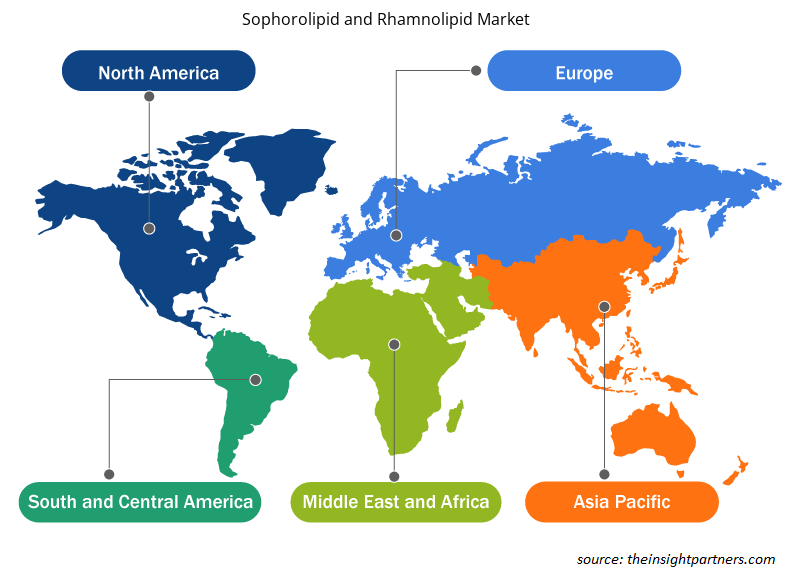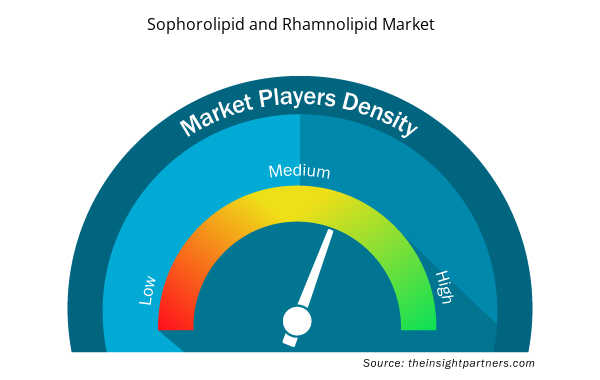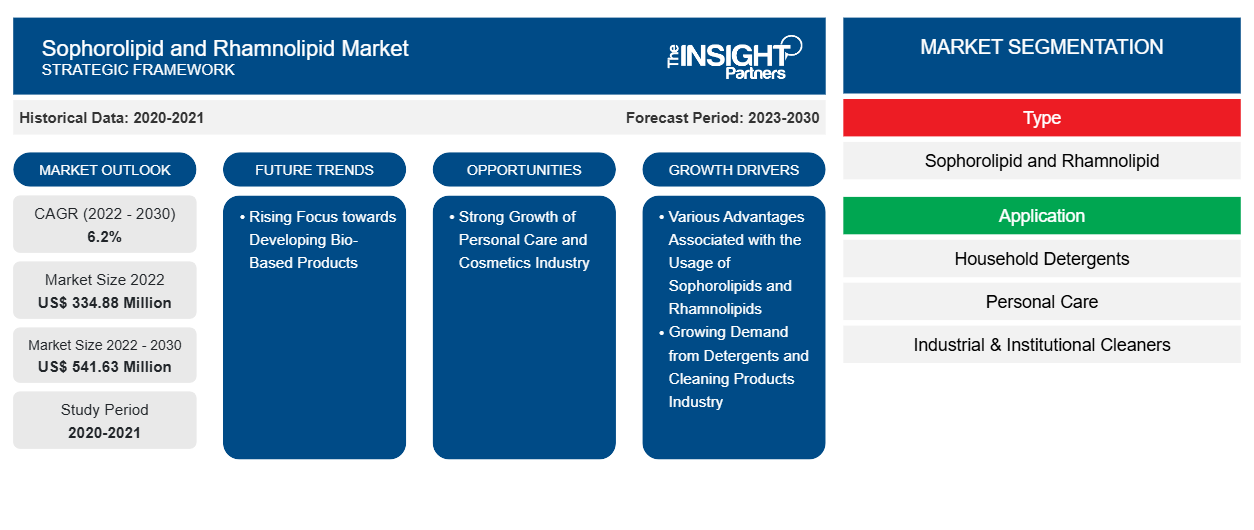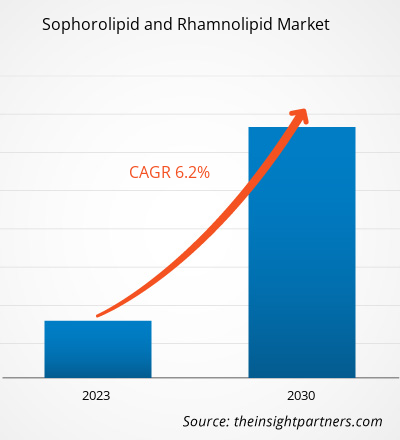[Forschungsbericht] Der Markt für Sophorolipide und Rhamnolipide soll von 334,88 Millionen US-Dollar im Jahr 2022 auf 541,63 Millionen US-Dollar im Jahr 2030 wachsen; von 2022 bis 2030 wird eine durchschnittliche jährliche Wachstumsrate (CAGR) von 6,2 % erwartet.
Markteinblicke und Analystenansichten:
Sophorolipide und Rhamnolipide werden aus natürlichen Quellen gewonnen. Die für die Herstellung von Sophorolipiden benötigten Rohstoffe sind Pflanzenöl, Zucker und nicht pathogene Hefen wie Candida batistae, C. apicola, Starmerella bombicola, Rhodotorula bogoriensis, Wickerhamiella domercqiae und Rhodotorula babjevae. Sophorolipide und Rhamnolipide werden in verschiedenen Anwendungen eingesetzt, beispielsweise in Haushaltsreinigern, Körperpflegemitteln, industriellen und institutionellen Reinigungsmitteln, Lebensmittelverarbeitung, Ölfeldchemikalien, Lederverarbeitung, Landwirtschaft und Pharmazeutika. Aufgrund der geringen Toxizität und hohen biologischen Abbaubarkeit von Sophorolipiden werden sie häufig als Biotenside verwendet, um die Oberflächen- und Grenzflächenspannung zu verringern, die Lösungsrate von Kohlenwasserstoffen zu erhöhen und die Solubilisierung und Absorption von Verbindungen zu erleichtern. Rhamnolipide haben aufgrund ihrer Ungiftigkeit, hohen biologischen Abbaubarkeit, niedrigen Oberflächenspannung und minimalen Hemmkonzentrationswerte in verschiedenen Sektoren Aufmerksamkeit erregt.
Wachstumstreiber und Herausforderungen:
Sophorolipide bieten gegenüber chemischen Tensiden mehrere Vorteile, wie z. B. eine hohe biologische Abbaubarkeit, eine Vielfalt biologischer Eigenschaften und erneuerbare Eigenschaften, da sie als Mischung verschiedener Moleküle synthetisiert werden. Sophorolipide haben verschiedene Eigenschaften, darunter antimikrobielle und antioxidative Aktivität, die ihre Anwendung in verschiedenen Branchen wie Waschmitteln und Körperpflege ermöglichen. Sie sind auch hocheffizient bei der Reduzierung der Oberflächen- und Grenzflächenspannungen. Darüber hinaus werden Rhamnolipide aufgrund ihrer effizienten Oberflächen- und biologischen Eigenschaften in vielen Branchen wie Bioremediation, Kosmetik, Landwirtschaft, Lebensmittelverarbeitung und Pharmazeutika häufig eingesetzt. Rhamnolipide senken effektiv die Oberflächenspannung, weisen eine geringe Toxizität auf, haben eine starke Benetzungsfähigkeit und fördern den biologischen Abbau schwer löslicher Substrate. Daher treiben die mit der Verwendung von Sophorolipiden und Rhamnolipiden verbundenen Vorteile das Wachstum des Sophorolipid- und Rhamnolipid-Marktes voran . Die hohen Kosten von Rhamnolipiden und Sophorolipiden beschränken jedoch ihre Verwendung in verschiedenen Anwendungsbereichen und bremsen das globale Wachstum des Sophorolipid- und Rhamnolipid-Marktes. Die Kosten für die Herstellung von Rhamnolipiden sind aufgrund der geringeren Erträge im Vergleich zu kommerziellen synthetischen Tensiden hoch. Hohe Rohstoffkosten, teure Reinigung und Weiterverarbeitung sind Schlüsselfaktoren, die die Produktionskosten erhöhen. Der Hauptnachteil von Sophorolipid ist sein hoher Preis. Die chemische Industrie sucht jedoch nach Möglichkeiten, die Produktionseffizienz zu verbessern und die Kosten zu senken. Viele Studien konzentrieren sich auf die Suche nach einem neuen kosteneffizienten Bioprozessumfeld.
Passen Sie diesen Bericht Ihren Anforderungen an
Sie erhalten kostenlos individuelle Anpassungen an jedem Bericht, einschließlich Teilen dieses Berichts oder einer Analyse auf Länderebene, eines Excel-Datenpakets sowie tolle Angebote und Rabatte für Start-ups und Universitäten.
- Holen Sie sich die wichtigsten Markttrends aus diesem Bericht.Dieses KOSTENLOSE Beispiel umfasst eine Datenanalyse von Markttrends bis hin zu Schätzungen und Prognosen.
Berichtssegmentierung und -umfang:
Der „Globale Sophorolipid- und Rhamnolipid-Markt“ ist nach Typ, Anwendung und Geografie segmentiert. Basierend auf dem Typ ist der Sophorolipid- und Rhamnolipid-Markt in Sophorolipid und Rhamnolipid segmentiert. In Bezug auf die Anwendung ist der Sophorolipid- und Rhamnolipid-Markt in Haushaltsreiniger, Körperpflege, industrielle und institutionelle Reiniger, Lebensmittelverarbeitung, Ölfeldchemikalien , Lederverarbeitung, Landwirtschaft, Pharmazeutika und andere segmentiert. Geografisch ist der Sophorolipid- und Rhamnolipid-Markt in Nordamerika (USA, Kanada und Mexiko), Europa (Deutschland, Frankreich, Italien, Großbritannien, Russland und der Rest von Europa), Asien-Pazifik (Australien, China, Japan, Indien, Südkorea und der Rest von Asien-Pazifik), den Nahen Osten und Afrika (Südafrika, Saudi-Arabien, die Vereinigten Arabischen Emirate und der Rest von Nahem Osten und Afrika) und Süd- und Mittelamerika (Brasilien, Argentinien und der Rest von Süd- und Mittelamerika) segmentiert.
Segmentanalyse:
Basierend auf dem Typ ist der Markt für Sophorolipide und Rhamnolipide in Sophorolipide und Rhamnolipide unterteilt. Das Sophorolipid-Segment hielt im Jahr 2022 einen bedeutenden Marktanteil an Sophorolipiden und Rhamnolipiden, und der Markt für das Segment wird voraussichtlich von 2022 bis 2030 erheblich wachsen. Sophorolipid-Moleküle besitzen hervorragende oberflächenaktive Eigenschaften, was sie für verschiedene Anwendungen wie Körperpflegeprodukte, Reinigungsmittel, Lebensmittelzusatzstoffe , Arzneimittel und Umweltsanierung wertvoll macht. In der Kosmetik haben Sophorolipide als natürliche und biologisch abbaubare Emulgatoren und Schaumbildner an Bedeutung gewonnen. Ihre Fähigkeit, Formulierungen zu stabilisieren und gleichzeitig sanft zur Haut zu sein, entspricht der zunehmenden Vorliebe der Verbraucher für umweltfreundliche und hautfreundliche Produkte.
Regionale Analyse:
Der Markt für Sophorolipide und Rhamnolipide ist in fünf Schlüsselregionen unterteilt: Nordamerika, Europa, Asien-Pazifik, Süd- und Mittelamerika sowie den Nahen Osten und Afrika. Europa dominierte den globalen Markt für Sophorolipide und Rhamnolipide, und der regionale Markt machte im Jahr 2022 etwa 120 Millionen US-Dollar aus. Nordamerika leistet ebenfalls einen wichtigen Beitrag und hält einen erheblichen Anteil am globalen Marktanteil von Sophorolipiden und Rhamnolipiden. Der nordamerikanische Markt wird voraussichtlich im Jahr 2030 über 140 Millionen US-Dollar erreichen. Der asiatisch-pazifische Markt wird voraussichtlich von 2022 bis 2030 eine beträchtliche durchschnittliche jährliche Wachstumsrate von über 7 % verzeichnen. Der Markt für Sophorolipide und Rhamnolipide im asiatisch-pazifischen Raum ist nach Ländern in Australien, China, Indien, Japan, Südkorea und den Rest des asiatisch-pazifischen Raums unterteilt. Der Markt wird von Faktoren wie der wachsenden Nachfrage der Wasch- und Reinigungsmittelindustrie und dem steigenden Bewusstsein für die Vorteile der Verwendung von Sophorolipiden und Rhamnolipiden getrieben. Diese biokompatiblen und umweltfreundlichen Biotenside haben aufgrund ihrer vielseitigen Anwendungsmöglichkeiten in Branchen wie Körperpflege, Pharmazie, Landwirtschaft und Ölförderung stark an Bedeutung gewonnen. Das steigende Bewusstsein für nachhaltige und umweltfreundliche Technologien dürfte die Nachfrage nach Sophorolipiden und Rhamnolipiden aufgrund ihrer Wirksamkeit bei der Reduzierung der Umweltbelastung ankurbeln. Darüber hinaus hat der zunehmende Fokus auf die Verringerung der Abhängigkeit von traditionellen Tensiden auf petrochemischer Basis Unternehmen im asiatisch-pazifischen Raum dazu veranlasst, in die Forschung, Entwicklung und Produktion dieser biobasierten Alternativen zu investieren.
Branchenentwicklungen und zukünftige Chancen:
Nachfolgend sind die Initiativen der wichtigsten Akteure auf dem Sophorolipid- und Rhamnolipid-Markt aufgeführt:
- Im Jahr 2023 gaben Holiferm Ltd und Sasol Chemicals, eine Geschäftseinheit von Sasol Ltd, eine Zusammenarbeit zur Herstellung und Vermarktung von Rhamnolipiden und Mannosyl-Erythritol-Lipiden (MELs) bekannt. Diese Zusammenarbeit erweitert die im März 2022 angekündigte Partnerschaft zwischen den beiden Unternehmen zur Entwicklung und Vermarktung eines weiteren Biotensidprodukts, Sophorolipiden.
- Im Jahr 2022 kündigte Evonik eine Investition in den Bau einer neuen Anlage zur Herstellung biobasierter und vollständig biologisch abbaubarer Rhamnolipide an. Die Investition am Standort Slovenská Ľupča in der Slowakei soll die 2019 begonnene Partnerschaft des Unternehmens mit dem Konsumgüterkonzern Unilever stärken.
- Im Jahr 2020 übernahm Stepan Co das NatSurFact-Geschäft von Logos Technologies LLC, eine auf Rhamnolipiden basierende Linie von Biotensiden aus erneuerbaren Quellen.
Regionale Einblicke in den Sophorolipid- und Rhamnolipid-Markt
Die regionalen Trends und Faktoren, die den Sophorolipid- und Rhamnolipid-Markt während des Prognosezeitraums beeinflussen, wurden von den Analysten von Insight Partners ausführlich erläutert. In diesem Abschnitt werden auch Sophorolipid- und Rhamnolipid-Marktsegmente und die Geografie in Nordamerika, Europa, im asiatisch-pazifischen Raum, im Nahen Osten und Afrika sowie in Süd- und Mittelamerika erörtert.

- Erhalten Sie regionalspezifische Daten zum Sophorolipid- und Rhamnolipid-Markt
Umfang des Marktberichts zu Sophorolipiden und Rhamnolipiden
| Berichtsattribut | Details |
|---|---|
| Marktgröße im Jahr 2022 | 334,88 Millionen US-Dollar |
| Marktgröße bis 2030 | 541,63 Millionen US-Dollar |
| Globale CAGR (2022 - 2030) | 6,2 % |
| Historische Daten | 2020-2021 |
| Prognosezeitraum | 2023–2030 |
| Abgedeckte Segmente | Nach Typ
|
| Abgedeckte Regionen und Länder | Nordamerika
|
| Marktführer und wichtige Unternehmensprofile |
|
Dichte der Marktteilnehmer für Sophorolipide und Rhamnolipide: Auswirkungen auf die Geschäftsdynamik verstehen
Der Markt für Sophorolipide und Rhamnolipide wächst rasant. Dies wird durch die steigende Nachfrage der Endverbraucher aufgrund von Faktoren wie sich entwickelnden Verbraucherpräferenzen, technologischen Fortschritten und einem größeren Bewusstsein für die Vorteile des Produkts vorangetrieben. Mit der steigenden Nachfrage erweitern Unternehmen ihr Angebot, entwickeln Innovationen, um die Bedürfnisse der Verbraucher zu erfüllen, und nutzen neue Trends, was das Marktwachstum weiter ankurbelt.
Die Marktteilnehmerdichte bezieht sich auf die Verteilung von Firmen oder Unternehmen, die in einem bestimmten Markt oder einer bestimmten Branche tätig sind. Sie gibt an, wie viele Wettbewerber (Marktteilnehmer) in einem bestimmten Marktraum im Verhältnis zu seiner Größe oder seinem gesamten Marktwert präsent sind.
Die wichtigsten auf dem Sophorolipid- und Rhamnolipid-Markt tätigen Unternehmen sind:
- Dow Inc
- Allied Carbon Solutions Co Ltd
- Saraya Co Ltd
- Evonik Industries AG
- Givaudan SA
Haftungsausschluss : Die oben aufgeführten Unternehmen sind nicht in einer bestimmten Reihenfolge aufgeführt.

- Überblick über die wichtigsten Akteure auf dem Sophorolipid- und Rhamnolipid-Markt
Auswirkungen der COVID-19-Pandemie:
Die COVID-19-Pandemie hatte negative Auswirkungen auf fast alle Branchen in verschiedenen Ländern. Lockdowns, Reisebeschränkungen und Betriebsschließungen in Nordamerika, Europa, im asiatisch-pazifischen Raum, in Süd- und Mittelamerika sowie im Nahen Osten und Afrika behinderten das Wachstum mehrerer Branchen, darunter der Chemie- und Materialindustrie. Die Schließung von Produktionseinheiten von Sophorolipid- und Rhamnolipid-Unternehmen störte die globalen Lieferketten, Produktionsaktivitäten und Lieferpläne. Verschiedene Unternehmen meldeten Verzögerungen bei Produktlieferungen und einen Einbruch der Produktverkäufe im Jahr 2020. Die negativen Auswirkungen der Pandemie auf das Wachstum von Branchen wie Lebensmittel, Körperpflege, Lederverarbeitung und anderen wirkten sich negativ auf das Wachstum des Sophorolipid- und Rhamnolipid-Marktes aus. Mehrere Branchen haben jedoch wieder mit voller Kapazität gearbeitet, da sich die Lieferengpässe allmählich auflösen, was die Nachfrage nach Sophorolipid und Rhamnolipid aus verschiedenen Branchen ankurbelt und das Wachstum des Sophorolipid- und Rhamnolipid-Marktes vorantreibt.
Wettbewerbslandschaft und Schlüsselunternehmen:
Dow Inc., Allied Carbon Solutions Co. Ltd., Saraya Co. Ltd., Evonik Industries AG, Givaudan SA, Godrej Industries Ltd., Holiferm Ltd., Stepan Co, Deguan Biosurfactant Supplier und Jeneil Bioproducts GmbH sind einige Akteure auf dem globalen Sophorolipid- und Rhamnolipid-Markt. Akteure auf dem globalen Sophorolipid- und Rhamnolipid-Markt konzentrieren sich auf die Bereitstellung hochwertiger Produkte, um die Kundennachfrage zu erfüllen. Sie konzentrieren sich auch auf die Umsetzung von Strategien wie die Einführung neuer Produkte, Kapazitätserweiterungen, Partnerschaften und Kooperationen, um auf dem Markt wettbewerbsfähig zu bleiben.
- Historische Analyse (2 Jahre), Basisjahr, Prognose (7 Jahre) mit CAGR
- PEST- und SWOT-Analyse
- Marktgröße Wert/Volumen – Global, Regional, Land
- Branche und Wettbewerbsumfeld
- Excel-Datensatz


- Dropshipping Market
- Virtual Pipeline Systems Market
- Medical and Research Grade Collagen Market
- Real-Time Location Systems Market
- USB Device Market
- Machine Condition Monitoring Market
- Nuclear Waste Management System Market
- Space Situational Awareness (SSA) Market
- Redistribution Layer Material Market
- Excimer & Femtosecond Ophthalmic Lasers Market

Report Coverage
Revenue forecast, Company Analysis, Industry landscape, Growth factors, and Trends

Segment Covered
This text is related
to segments covered.

Regional Scope
North America, Europe, Asia Pacific, Middle East & Africa, South & Central America

Country Scope
This text is related
to country scope.
Häufig gestellte Fragen
A few players operating in the global sophorolipid and rhamnolipid market include Dow Inc, Allied Carbon Solutions Co Ltd, Saraya Co Ltd, Evonik Industries AG, Givaudan SA, Godrej Industries Ltd, Holiferm Ltd, Stepan Co, Deguan Biosurfactant Supplier, and Jeneil Bioproducts GmbH.
In 2022, Europe held the largest share of the global sophorolipid and rhamnolipid market. In Europe, the increasing use of sophorolipid and rhamnolipid in detergents, cleaning products, personal care and cosmetic products, food processing, pharmaceuticals, and many other applications is driving market growth.
The sophorolipid segment held the largest share in the global sophorolipid and rhamnolipid market in 2022. Sophorolipid molecules possess excellent surface-active properties, making them valuable in various applications such as personal care products, detergents, food additives, pharmaceuticals, and environmental remediation.
The household detergents segment held the largest share of the global sophorolipid and rhamnolipid market in 2022. Sophorolipids and rhamnolipids have shown effective results in hard surface cleaning and automated dishwashing aid formulations. Sophorolipid and rhamnolipids-based detergents are biodegradable and environmentally friendly.
The projected growth of the market is attributed to the advantages associated with usage of sophorolipids and rhamnolipids and the growing demand from detergents & cleaning products industry.
Asia Pacific is estimated to register the fastest CAGR in the global sophorolipid and rhamnolipid market over the forecast period. The market is driven by factors such as the growing demand from the detergents & cleaning products industry and rising awareness regarding advantages associated with using sophorolipids and rhamnolipids.
The List of Companies - Sophorolipid and Rhamnolipid Market
- Dow Inc
- Allied Carbon Solutions Co Ltd
- Saraya Co Ltd
- Evonik Industries AG
- Givaudan SA
- Godrej Industries Ltd
- Holiferm Ltd
- Stepan Co
- Deguan Biosurfactant Supplier
- Jeneil Bioproducts GmbH.
The Insight Partners performs research in 4 major stages: Data Collection & Secondary Research, Primary Research, Data Analysis and Data Triangulation & Final Review.
- Data Collection and Secondary Research:
As a market research and consulting firm operating from a decade, we have published and advised several client across the globe. First step for any study will start with an assessment of currently available data and insights from existing reports. Further, historical and current market information is collected from Investor Presentations, Annual Reports, SEC Filings, etc., and other information related to company’s performance and market positioning are gathered from Paid Databases (Factiva, Hoovers, and Reuters) and various other publications available in public domain.
Several associations trade associates, technical forums, institutes, societies and organization are accessed to gain technical as well as market related insights through their publications such as research papers, blogs and press releases related to the studies are referred to get cues about the market. Further, white papers, journals, magazines, and other news articles published in last 3 years are scrutinized and analyzed to understand the current market trends.
- Primary Research:
The primarily interview analysis comprise of data obtained from industry participants interview and answers to survey questions gathered by in-house primary team.
For primary research, interviews are conducted with industry experts/CEOs/Marketing Managers/VPs/Subject Matter Experts from both demand and supply side to get a 360-degree view of the market. The primary team conducts several interviews based on the complexity of the markets to understand the various market trends and dynamics which makes research more credible and precise.
A typical research interview fulfils the following functions:
- Provides first-hand information on the market size, market trends, growth trends, competitive landscape, and outlook
- Validates and strengthens in-house secondary research findings
- Develops the analysis team’s expertise and market understanding
Primary research involves email interactions and telephone interviews for each market, category, segment, and sub-segment across geographies. The participants who typically take part in such a process include, but are not limited to:
- Industry participants: VPs, business development managers, market intelligence managers and national sales managers
- Outside experts: Valuation experts, research analysts and key opinion leaders specializing in the electronics and semiconductor industry.
Below is the breakup of our primary respondents by company, designation, and region:

Once we receive the confirmation from primary research sources or primary respondents, we finalize the base year market estimation and forecast the data as per the macroeconomic and microeconomic factors assessed during data collection.
- Data Analysis:
Once data is validated through both secondary as well as primary respondents, we finalize the market estimations by hypothesis formulation and factor analysis at regional and country level.
- Macro-Economic Factor Analysis:
We analyse macroeconomic indicators such the gross domestic product (GDP), increase in the demand for goods and services across industries, technological advancement, regional economic growth, governmental policies, the influence of COVID-19, PEST analysis, and other aspects. This analysis aids in setting benchmarks for various nations/regions and approximating market splits. Additionally, the general trend of the aforementioned components aid in determining the market's development possibilities.
- Country Level Data:
Various factors that are especially aligned to the country are taken into account to determine the market size for a certain area and country, including the presence of vendors, such as headquarters and offices, the country's GDP, demand patterns, and industry growth. To comprehend the market dynamics for the nation, a number of growth variables, inhibitors, application areas, and current market trends are researched. The aforementioned elements aid in determining the country's overall market's growth potential.
- Company Profile:
The “Table of Contents” is formulated by listing and analyzing more than 25 - 30 companies operating in the market ecosystem across geographies. However, we profile only 10 companies as a standard practice in our syndicate reports. These 10 companies comprise leading, emerging, and regional players. Nonetheless, our analysis is not restricted to the 10 listed companies, we also analyze other companies present in the market to develop a holistic view and understand the prevailing trends. The “Company Profiles” section in the report covers key facts, business description, products & services, financial information, SWOT analysis, and key developments. The financial information presented is extracted from the annual reports and official documents of the publicly listed companies. Upon collecting the information for the sections of respective companies, we verify them via various primary sources and then compile the data in respective company profiles. The company level information helps us in deriving the base number as well as in forecasting the market size.
- Developing Base Number:
Aggregation of sales statistics (2020-2022) and macro-economic factor, and other secondary and primary research insights are utilized to arrive at base number and related market shares for 2022. The data gaps are identified in this step and relevant market data is analyzed, collected from paid primary interviews or databases. On finalizing the base year market size, forecasts are developed on the basis of macro-economic, industry and market growth factors and company level analysis.
- Data Triangulation and Final Review:
The market findings and base year market size calculations are validated from supply as well as demand side. Demand side validations are based on macro-economic factor analysis and benchmarks for respective regions and countries. In case of supply side validations, revenues of major companies are estimated (in case not available) based on industry benchmark, approximate number of employees, product portfolio, and primary interviews revenues are gathered. Further revenue from target product/service segment is assessed to avoid overshooting of market statistics. In case of heavy deviations between supply and demand side values, all thes steps are repeated to achieve synchronization.
We follow an iterative model, wherein we share our research findings with Subject Matter Experts (SME’s) and Key Opinion Leaders (KOLs) until consensus view of the market is not formulated – this model negates any drastic deviation in the opinions of experts. Only validated and universally acceptable research findings are quoted in our reports.
We have important check points that we use to validate our research findings – which we call – data triangulation, where we validate the information, we generate from secondary sources with primary interviews and then we re-validate with our internal data bases and Subject matter experts. This comprehensive model enables us to deliver high quality, reliable data in shortest possible time.


 Holen Sie sich ein kostenloses Muster für diesen Bericht
Holen Sie sich ein kostenloses Muster für diesen Bericht